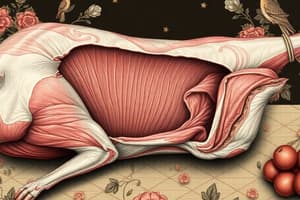Podcast
Questions and Answers
What metabolic shift occurs in muscle after an animal is slaughtered?
What metabolic shift occurs in muscle after an animal is slaughtered?
- From aerobic to anaerobic metabolism (correct)
- From glycolytic to oxidative metabolism
- From anaerobic to aerobic metabolism
- From aerobic to oxidative metabolism
Which of the following changes occur during rigor mortis?
Which of the following changes occur during rigor mortis?
- Myosin heads form tight bonds with actin (correct)
- Creatine Phosphate (CP) levels rise
- ATP levels increase significantly
- Muscle extensibility remains unaffected
What is the primary cause of muscle rigidity in rigor mortis?
What is the primary cause of muscle rigidity in rigor mortis?
- Accumulation of oxygen
- Excess production of carbon dioxide
- Depletion of muscle glycogen
- Full depletion of ATP and creatine phosphate (correct)
During which phase of rigor mortis do myosin heads begin to form bonds with actin?
During which phase of rigor mortis do myosin heads begin to form bonds with actin?
How long does it typically take for poultry to reach rigor mortis after exsanguination?
How long does it typically take for poultry to reach rigor mortis after exsanguination?
What happens to muscle extensibility as rigor mortis progresses?
What happens to muscle extensibility as rigor mortis progresses?
What metabolic byproduct contributes to the conditions of rigor mortis?
What metabolic byproduct contributes to the conditions of rigor mortis?
What is the result of the exhaustive muscular contraction during rigor mortis?
What is the result of the exhaustive muscular contraction during rigor mortis?
What is the primary characteristic of red muscles?
What is the primary characteristic of red muscles?
How does stress impact post-mortem glycolysis?
How does stress impact post-mortem glycolysis?
Which of the following drugs is known to accelerate the rate of glycolysis?
Which of the following drugs is known to accelerate the rate of glycolysis?
What effect does temperature have on post-mortem glycolysis?
What effect does temperature have on post-mortem glycolysis?
Which pig breed is notably prone to PSE due to glycolysis rates?
Which pig breed is notably prone to PSE due to glycolysis rates?
Rigor mortis is significant for which of the following reasons?
Rigor mortis is significant for which of the following reasons?
What role does the method of slaughter play in glycolysis?
What role does the method of slaughter play in glycolysis?
What can result in the absence of post-mortem glycolysis?
What can result in the absence of post-mortem glycolysis?
What is the primary role of calpastatins in the muscle aging process?
What is the primary role of calpastatins in the muscle aging process?
What is the main consequence of excessive ante mortem stress in muscle?
What is the main consequence of excessive ante mortem stress in muscle?
Which factor is a significant contributor to the development of DFD muscle?
Which factor is a significant contributor to the development of DFD muscle?
Which of the following best explains the difference between PSE and DFD muscle?
Which of the following best explains the difference between PSE and DFD muscle?
What does a higher level of calpastatin in an animal imply about its meat tenderness?
What does a higher level of calpastatin in an animal imply about its meat tenderness?
Which of the following factors is categorized as intrinsic in rigor mortis development?
Which of the following factors is categorized as intrinsic in rigor mortis development?
How does the age of the animal affect the ultimate pH of its meat?
How does the age of the animal affect the ultimate pH of its meat?
What physiological change occurs due to high levels of ante mortem stress?
What physiological change occurs due to high levels of ante mortem stress?
Flashcards are hidden until you start studying
Study Notes
Rigor Mortis
- The process after slaughter where muscle tissue transitions to meat.
- Involves a shift from aerobic to anaerobic metabolism, leading to the depletion of oxygen.
- Glycogen is converted to lactic acid, lowering muscle pH.
- Myosin heads form a tight bond with actin, resulting in muscle stiffness (rigor mortis).
- Proteolysis (protein breakdown) begins, tenderizing meat.
Phases of Rigor Mortis
- Delay phase: Muscle remains relaxed due to sufficient ATP.
- Onset phase: ATP and Creatine Phosphate (CP) are depleted, leading to the formation of rigor bonds.
- Completion phase: CP is exhausted, resulting in full rigor mortis.
Factors Influencing Rigor Mortis onset
- Time: Poultry reaches rigor within 1-2 hours, pork within 4-6 hours, beef/lamb within 7-15 hours.
- Species: Pig muscles reach rigor faster than cattle or sheep.
- Muscle type: White muscles (fast twitch) have faster glycolysis than red muscles (slow twitch).
Factors Affecting Rigor Mortis (Intrinsic)
- Animal species: Different species have varying rates of glycolysis.
- Age & Sex: Older animals and entire males have lower ultimate pH values.
- Type of muscle: White muscle has a higher rate of glycolysis due to higher levels of ATP-ase, creatine phosphate, and glycogen.
- Pathology: Diseased or fatigued animals may not experience post-mortem glycolysis.
- Genotype: Breed and genotype can influence glycolysis, with certain breeds (e.g., Large White pigs) being prone to PSE.
Factors Affecting Rigor Mortis (Extrinsic)
- Stress: Pre-slaughter stress, fasting, high/low temperatures, and mishandling can accelerate glycolysis.
- Pre-slaughter drug administration: Drugs can alter glycolysis. Calcium salts increase the rate, while magnesium salts decrease it.
- Temperature: High temperatures increase glycolysis, while low temperatures decrease it.
- Method of slaughter: Techniques like pithing can accelerate glycolysis.
Significance of Rigor Mortis
- Meat quality: Acidification due to rigor mortis retards putrefaction, extending meat's shelf life.
- Meat quality assessment: The degree of rigor mortis can be used to assess meat's keeping quality.
Abnormal Meat Conditions
- PSE (Pale, Soft, Exudative) muscle: Occurs due to ante-mortem stress, causing rapid pH drop and muscle degradation.
- DFD (Dark, Firm, Dry) muscle: Occurs due to lack of glycogen at slaughter, resulting in higher pH and muscle firmness.
PSE Muscle Characteristics
- Pale color
- Soft texture
- Increased water exudation
- Negative impact on sales appeal and shelf life
DFD Muscle Characteristics
- Dark color
- Firm texture
- Dry surface
- Sweeter flavor
- Less common in poultry, more common in beef
- Solution: Feed and rest animals for 24-48 hours before slaughter.
Studying That Suits You
Use AI to generate personalized quizzes and flashcards to suit your learning preferences.




